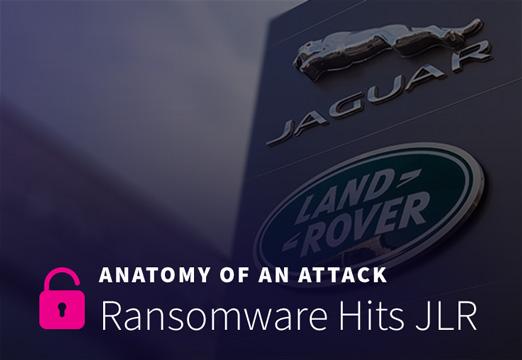Ransomware Hits JLR Supply Chain, Results in Five Week Disruption
Back to top
October 17, 2025
Anatomy of an Attack
Ransomware Hits JLR Supply Chain, Results in Five Week Disruption
A Supply Chain Under Siege
The automotive industry, a cornerstone of global manufacturing, is increasingly a target for sophisticated cybercriminals. Attacks include the 2022 breaches on Toyota and General Motors, 2023 attacks on Nissan and Ferrari, and the 2024 cyberattacks on Hyundai Motor Europe. The recent ransomware attack on Jaguar Land Rover (JLR) is a sharp reminder of the devastating impact these breaches can have on a company's operations and its intricate global supply chain.
The Breach: A Disruption Felt Globally
At the end of August, JLR experienced a significant cyber incident that forced an emergency shutdown of its global IT infrastructure. The attack caused immediate and severe disruptions at key manufacturing sites leading to a halt in production.
Initial reports from JLR stated that the company proactively shut down systems to mitigate the spread of the attack, with an ongoing effort to restart global applications in a controlled manner. While JLR initially stated there was no evidence of customer data theft, further investigation revealed that "some data" had been affected, prompting JLR to inform regulators and commit to contacting affected individuals.
The affected production lines began a phased restart on Wed Oct 8, five weeks after the attack. The economic effect of the prolonged shutdown was so severe that it led the UK government to announce a £1.5 billion loan guarantee to “give certainty to its supply chain following a recent cyber-attack”.
The Attackers: Evolving Ransomware Tactics
A Telegram channel named Scattered Lapsus$ Hunters took credit for the attack. The channel name is a merging of three threat actor groups: Scattered Spider, Lapsus$, and ShinyHunters, all of which are associated with “the Com” described here).
MITRE ATT&CK Techniques and Potential Vulnerabilities
Based on public reporting on the JLR cyberattack, it's challenging to pinpoint a specific CVE with absolute certainty, as the company has not publicly confirmed the exact initial access vector.
However, we can infer the likely types of vulnerabilities and attack methods that correspond to the MITRE ATT&CK tactics, techniques and procedures (TTPs) observed in this incident and in similar attacks.
Initial Access (TA0001)
- Phishing (T1566) and Valid Accounts (T1078): A common initial access method for groups like Scattered Spider and Lapsus$ is social engineering. They exploit human vulnerabilities to obtain valid credentials (T1078) via phishing or vishing.
- Likely Vulnerability Type: Human factor (lack of security awareness), weak MFA policies, and lack of credential stuffing protections.
- Exploit Public-Facing Application (T1190): This is the most widely reported initial access vector linked to the JLR attack. While JLR has not officially confirmed it, the Clop ransomware group and other actors known for a similar style of attack have frequently used this tactic.
- Likely Vulnerability Type: Unpatched software, zero-day exploits, and misconfigurations in internet-facing services.
- Example CVEs: CVE-2023-27350 (MOVEit Transfer vulnerability, a known Clop vector for data exfiltration) or CVE-2021-44228 (Log4Shell, a critical vulnerability in Apache Log4j).
Execution and Post-Exploitation TTPs
- Defense Evasion (T1564.004) and Lateral Movement (TA0008): Attackers often use "living off the land" (LOTL) techniques, abusing native system tools like PowerShell or RDP to evade detection and move through the network. The JLR attack's stealthy nature points to a reliance on these methods rather than a new, custom malware.
- Likely Vulnerability Type: Misconfigured network policies (e.g., lack of network segmentation), insufficient logging, or a failure to monitor for anomalous lateral activity.
- Impact (TA0040) and Data Exfiltration: The final goal is to impact the business, typically through data theft and encryption. In JLR's case, the attackers' goal was data exfiltration, which forced the company to proactively shut down production.
- Likely Vulnerability Type: Misconfigured databases, inadequate data loss prevention (DLP) controls, or a lack of real-time monitoring of large-scale data transfers.
The ExtraHop Difference: Shine a Light on the Unknown
In a landscape where attackers continuously evolve their tactics, traditional security measures often prove insufficient. ExtraHop can often detect the TTP activity that threat actors use to target the vulnerabilities that may have led to the JLR attack by focusing on an attacker's behavior rather than their tools.
How ExtraHop Helps to Detect Stealthy Threat Actors
Ransomware attacks are not a single event; they are a multi-stage campaign. The time between the initial network compromise and the final encryption or exfiltration is a crucial window for defenders. ExtraHop RevealX NDR provides the deep visibility needed to detect these attacks across every phase of the ransomware kill chain, from initial access to impact.
- Comprehensive Network Visibility.Holistic visibility of all network activity counters threat actor tactics. RevealX fully decrypts and decodes protocols, including business applications and APIs often abused for data theft or lateral movement. Security teams gain visibility into encrypted traffic, eliminating blind spots that hide reconnaissance or credential misuse. Supporting over 90 protocols across hybrid and multi-cloud environments, RevealX exposes access points like phishing or exploited apps that frequently lead to ransomware.
- Behavioral Anomaly Detection.Advanced machine learning detects anomalous network activity in real-time. The platform identifies early ransomware behaviors like reconnaissance scans or privilege escalation, as well as mid-game tactics such as data staging and lateral movement. By surfacing these subtle attacker signals before encryption begins, RevealX enables earlier disruption of ransomware campaigns.
- Forensic Analysis.High-fidelity forensics map attacker movement and assess impact after an incident. By turning network data into actionable insights, teams can trace the attacker’s movements to see systems and data accessed. Continuous traffic lookback and immutable packet records help investigations move quickly, reducing both damage and recovery time.
- Real-time Threat Intelligence Integration.Correlated network activity with live threat intelligence delivers real-time context. Integrations with sources like CrowdStrike Falcon Intelligence enrich detections with IOCs, threat categories, and adversary techniques. Connections to ransomware C2 servers are automatically flagged, providing early warning of active campaigns.
- Accelerated Incident Response.High-fidelity, high-confidence alerts enriched with network context allow teams to respond faster and shrink dwell time. RevealX maps attacker paths, identifies compromised assets, and provides the forensic detail needed to take precise actions, such as isolating a host, to contain ransomware and minimize impact.
Conclusion
The JLR incident serves as a powerful case study highlighting the ability of threat actors to compromise supply chains by evading traditional defenses. Their tactics, from exploiting vulnerabilities in public-facing applications to moving laterally through the network, are designed to bypass security tools that rely on a legacy perimeter model. ExtraHop RevealX provides this capability, offering greater visibility into the network’s traffic and leveraging behavioral analytics to detect the subtle, hidden threats that would otherwise go unnoticed.
Endnotes
- JLR Cyberattack Halts UK Production and IT Systems
- JLR Cyber Attack: The Global Supply Chain Impact
- Jaguar Land Rover Staff Stay Home After Cyber Attack | Technology Magazine
- JLR attack: How ransomware gangs have changed from cartels to cliques
- Hackers linked to M&S breach claim responsibility for Jaguar Land Rover cyber-attack
- Statement on Cyber Incident
- Stealth Malware Attacks, Jaguar Land Rover Breach, & More
- Mind the Cyber Gap: Key Insights from Upstream’s 2025 Automotive Cybersecurity Report
- Cyberattack on JLR Prompts £1.5 Billion UK Government Intervention
- Inside Jaguar Land Rover factory in phased restart after cyber attack halted production
Discover more

Head of Product Marketing & Technical Marketing
Patrick Bedwell is an accomplished product marketing leader with deep expertise in the cybersecurity sector. He has a proven track record of leading high-performing teams at companies like Fortinet and Lastline. He holds an MBA from Santa Clara University.









